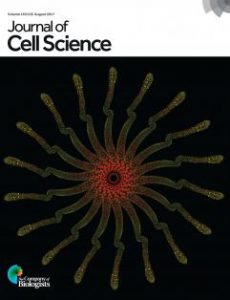 A journal has issued expression of concerns (EOCs) for four papers after a concerned reader notified the editors of issues in several figures.
A journal has issued expression of concerns (EOCs) for four papers after a concerned reader notified the editors of issues in several figures.
According to the EOCs, the Journal of Cell Science (JCS) discussed the concerns with the corresponding author, José Ignacio Rodriguez-Crespo, and subsequently notified his institution, Complutense University of Madrid. Last year, all four papers were questioned on PubPeer (1, 2, 3, 4).
The journal’s executive editor, Sharon Ahmad, told us:
We were made aware of the issues by a reader, and the concerns are the same as those highlighted on the PubPeer website. The university is conducting an investigation, and we are waiting for its conclusion.
The rector of the university, Carlos Andradas Heranz, confirmed that the university is aware of the issues and investigating. Jesus Perez Gil, director of the department where Rodriguez-Crespo works at Complutense University, told us:
A report will be delivered in due time. Until then, there is no other information available.
Rodriguez-Crespo, the corresponding author on all four papers, also told us:
An Ethics Commission at Complutense University was appointed last week and they met with me in order to analyze the questions raised by PubPeer. All the laboratory notebooks were provided and they inspected them carefully in order to analyze the experiments in question.
Here’s the EOC for “Distance-dependent cellular palmitoylation of de-novo-designed sequences and their translocation to plasma membrane subdomains,” published in 2002:
This Expression of Concern relates to the article ‘Distance-dependent cellular palmitoylation of de-novo-designed sequences and their translocation to plasma membrane subdomains’ by Inmaculada Navarro-Lérida, Alberto Álvarez-Barrientos, Francisco Gavilanes and Ignacio Rodríguez-Crespo. J. Cell Sci. (2002). 115, 3119-3130.
We have recently been made aware of concerns regarding some of the data in Fig. 1. After discussion with the corresponding author, Ignacio Rodríguez-Crespo, we have referred this matter to Dr Rodriguez-Crespo’s institute. Journal of Cell Science is publishing this note to make readers aware of the issue, and we will provide further information once it has been resolved.
This course of action follows the advice set out by COPE (Committee on Publication Ethics), of which Journal of Cell Science is a member.
The paper has been cited 36 times, according to Clarivate Analytics’ Web of Science
Here’s the similarly worded EOC for “N-terminal palmitoylation within the appropriate amino acid environment conveys on NOS2 the ability to progress along the intracellular sorting pathways:”
This Expression of Concern relates to the article ‘N-terminal palmitoylation within the appropriate amino acid environment conveys on NOS2 the ability to progress along the intracellular sorting pathways’ by Inmaculada Navarro-Lérida, Alberto Álvarez-Barrientos and Ignacio Rodríguez-Crespo. J. Cell Sci. (2006). 119, 1558-1569 (doi: 10.1242/jcs.02878).
We have recently been made aware of concerns regarding some of the data in Fig. 1C and Fig. 3A. After discussion with the corresponding author, Ignacio Rodríguez-Crespo, we have referred this matter to Dr Rodríguez-Crespo’s institute. Journal of Cell Science is publishing this note to make readers aware of the issue, and we will provide further information once it has been resolved.
The paper, published online in March 2006, has been cited 15 times. The PubPeer thread highlighted possible image duplication in the 2006 paper, comparing Figure 1C and 3A to two figures from a 2004 paper from Rodríguez-Crespo, published in the Journal of Biological Chemistry and also flagged on PubPeer.
The 2006 JCS paper also received an erratum in May 2006, in which the authors apologized that the e-press version of the article “indicated the existence of supplementary material, whereas this article has none.”
Here’s the EOC for “Induction of nitric oxide synthase-2 proceeds with the concomitant downregulation of the endogenous caveolin levels:”
This Expression of Concern relates to the article ‘Induction of nitric oxide synthase-2 proceeds with the concomitant downregulation of the endogenous caveolin levels’ by Inmaculada Navarro-Lérida, María Teresa Portolés, Alberto Álvarez Barrientos, Francisco Gavilanes, Lisardo Boscá and Ignacio Rodríguez-Crespo. J. Cell Sci. (2004). 117, 1687-1697 (doi: 10.1242/jcs.01002).
We have recently been made aware of concerns regarding some of the data in Fig. 4A and Fig. 6A. After discussion with the corresponding author, Ignacio Rodríguez-Crespo, we have referred this matter to Dr Rodríguez-Crespo’s institute. Journal of Cell Science is publishing this note to make readers aware of the issue, and we will provide further information once it has been resolved.
The paper, published in 2004, has been cited 12 times.
And here’s the fourth EOC:
This Expression of Concern relates to the article ‘Protein kinase D activity controls endothelial nitric oxide synthesis’ by Clara Aicart-Ramos, Lucía Sánchez-Ruiloba, Mónica Gómez-Parrizas, Carlos Zaragoza, Teresa Iglesias and Ignacio Rodríguez-Crespo. J. Cell Sci. (2014). 127, 3360-3372 (doi: 10.1242/jcs.148601).
We have recently been made aware of concerns regarding some of the data in Fig. 4J. After discussion with the corresponding author, Ignacio Rodríguez-Crespo, we have referred this matter to Dr Rodríguez-Crespo’s institute. Journal of Cell Science is publishing this note to make readers aware of the issue, and we will provide further information once it has been resolved.
The paper, “Protein kinase D activity controls endothelial nitric oxide synthesis,” was published in 2014 and has been cited five times. The notice and the comment in PubPeer refer to issues in Figure 4J, but there is no Figure 4J in the paper. Figure 4 only has panels A-C. However, the Figure 4J flagged in PubPeer and Figure 4 in the paper appear to be the same image.
Like Retraction Watch? Consider making a tax-deductible contribution to support our growth. You can also follow us on Twitter, like us on Facebook, add us to your RSS reader, sign up on our homepage for an email every time there’s a new post, or subscribe to our daily digest. Click here to review our Comments Policy. For a sneak peek at what we’re working on, click here.